8th Pink Day Festival Announced For June 27th With the Best of Rosé Wines!
June 14, 2021 - A press conference was held announcing the 8th Pink Day and its interesting program. In addition to socializing with winemakers and olive growers, this favorite wine event will be marked by an entertainment program, so visitors and exhibitors can expect various surprises and even more beautiful and modern space.
This year, the 8th Pink Day International Festival of Rose Wines, Sparkling Wines, and Champagnes is being held for the first time on the covered open terrace of the MSU Museum in New Zagreb, on Sunday, June 27. Although the location and date of the event have been changed several times due to epidemiological reasons and the consequences of the Zagreb earthquake, the festival successfully brings together numerous domestic and foreign producers of rosé wines, about fifty of them, with about 100 labels of rosé wines. Winemakers, oenologists, professionals, experts, and rosé lovers will take part, and there is, of course, an important part of the Festival: Green in Pink, with a dozen of the best Croatian producers of extra virgin olive oil.
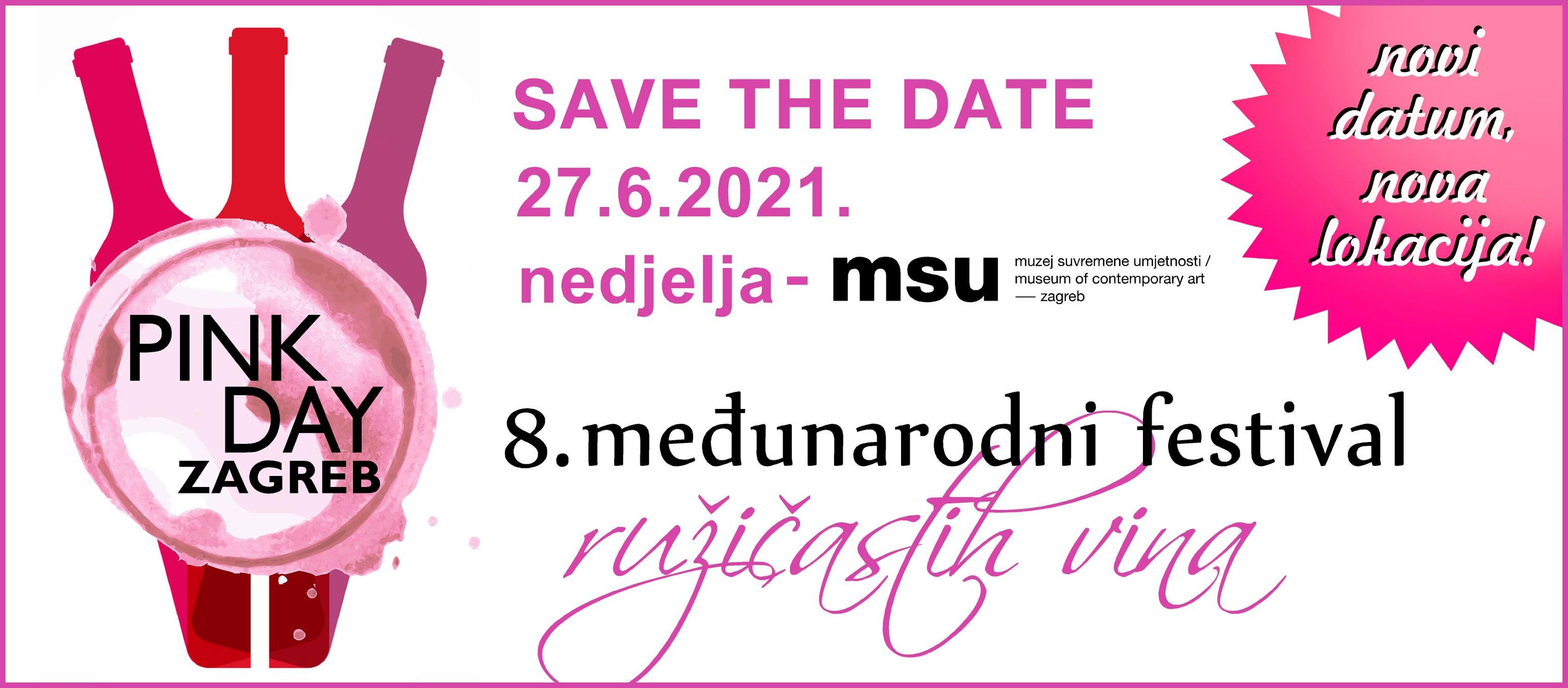
From Pink Day Official Facebook Page
At the press conference, WOW President and Pink Day founder Sanja Muzaferija, accompanied by art director Vlasta Pirnat, hostess Ana Lisak and MSU representatives, and in the presence of the co-organizer, IMC presented the novelties of the 8th Pink Day. Although the Festival always offers three or more wine and olive oil workshops, now for the first time, in cooperation with the Miva Wine Gallery, a Masterclass - World of Pink Champagnes by Moët Hennessy Group powered by Premium Visa has been organized, which has aroused great interest and sold out. just a few days. Visitors can expect two more workshops: Pink Austria, powered by Austrian Wine and with the help of the Office of the Federal Ministry of Agriculture, Regions, and Tourism at the Embassy of the Republic of Austria dedicated to Austrian rosés, and a workshop of extra virgin olive oils, Istria: Queen of Olive Oil powered by Catering Lisak, led by the famous Istrian expert Edi Družetić, who last year celebrated 40 years of work in olive growing.
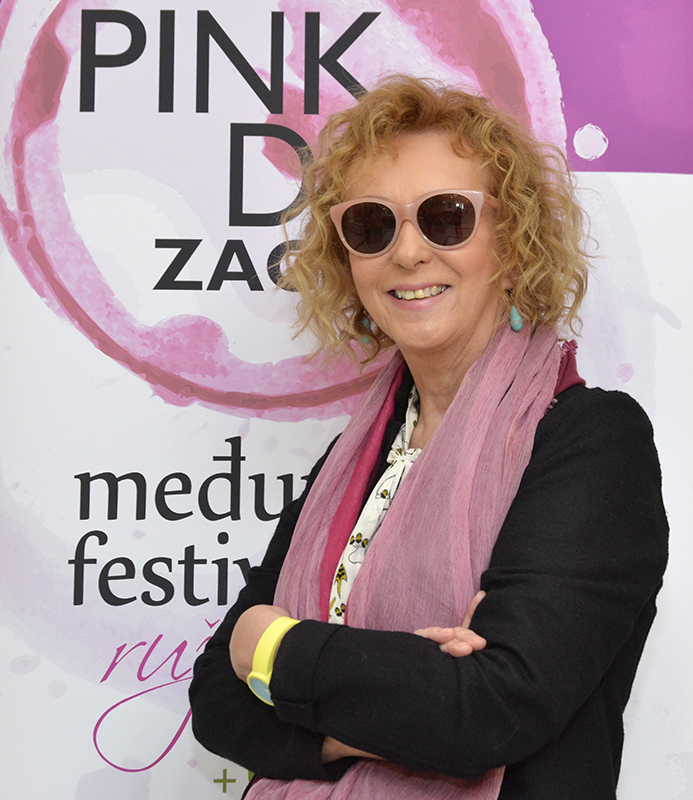
Sanja Muzaferija, Pink Day founder
‘‘I am extremely proud that this year our partner country is Austria and that, despite still somewhat problematic conditions, five exhibitors are coming from Austria, all under the auspices of Austrian Wine, but I am most looking forward to the exhibition venues of this year's Pink Day filled three weeks before the Festival. It is also important to me that we try, and I believe we succeed, to combine everything: to entertain, teach, cheer and celebrate rosé wines in a rosy mood. And let’s not forget the health and extra virgin olive oils. I thank the media that follow us faithfully and everyone who experiences Pink Day the way I imagined it: as a festival of optimism and enjoyment’’, said Muzaferija.
The ticket price for Pink Day is 150 kuna, while for members of the WOW association it is 50 kuna, and you can buy it at the entrance of the festival.
This year, Pink Day emphasizes the sale of wine, since last year was also extremely difficult for winemakers, and each winemaker will receive ten pink bags as a gift from the festival to sell their wine. Also, Pink Day continues to reward the most imaginative and creatively decorated exhibition table. Last year's prize, pink Jimmy Choo shoes, was won by the Italian winery Bottega, and this time as many as 4 prizes will be awarded. It will again be pink Jimmy Choo shoes: this time a Smokey model worth a thousand dollars, a work of art "DESIDERIO N° 1 ART MUST BE TASTED" by Austrian artist Andrew Stix, made especially for Pink Day, as well as Privee cosmetics Nikel, Croatian innovator Mirjana Brlečić, but also the ingenious bottle cap Coravin, worth 300 euros.
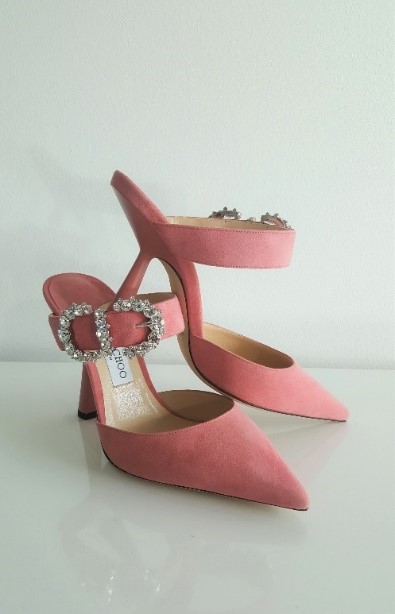
Pink Jimmy Choo shoes, last year's festival prize
Additionally, the current offer of all Croatian rosés will be judged by an independent jury composed of the most experienced Croatian wine judges. It is a mini-project "Drink Pink" conceived as part of the iVino concept, whose founders are journalists Ana Rogač and Ivo Kozarčanin. The best rosé wines of their choice and judgment decided, logically, to present and announce the winners, right on Pink Day.
As part of the press conference, Kutjevo held a presentation of the limited label Premium rosé, designed by the art director of Pink Day, Vlasta Pirnat, and the famous winemaker from Plešivica, Krešimir Ivančić, presented his Provencal-style rosé, Griffin Ambassador rosé. and Istrian olive oils were also tasted.
All of the above and much more interesting content await you at the 8th Pink Day, June 27, 2021, at the Zagreb Museum of Contemporary Art, MSU. All visitors will receive pink glasses as a gift until stocks run out so that after a long pandemic period they can try to look at the world more brightly and optimistically.
To learn more about the 8th Pink Festival, be sure to follow their Facebook and Instagram official accounts to find more information.
Croatian wines and grapes are among the best in the world, and you can find more information about them in Total Croatia’s Guide to Croatian Wine HERE.
For more on lifestyle in Croatia, follow TCN's dedicated page.
Slatina Sparkling Wine Find Makes Slavonia Champagne Among Croatia's Oldest
February 13, 2021 – A newly discovered, fully preserved bottle of 'Slavonia champagne' is unique evidence that Slatina sparkling wine is among the oldest in Croatia. Its fascinating history stretches back over 150 years
A completely preserved Slatina sparkling wine bottle from the period from 1864 to 1912 has been discovered during building works of Slatina's new visitor's centre. Found at a depth of two metres, the bottle is physical proof of what was previously known only from records – this 'Slavonia champagne' is among the oldest sparkling wine to have been made in Croatia.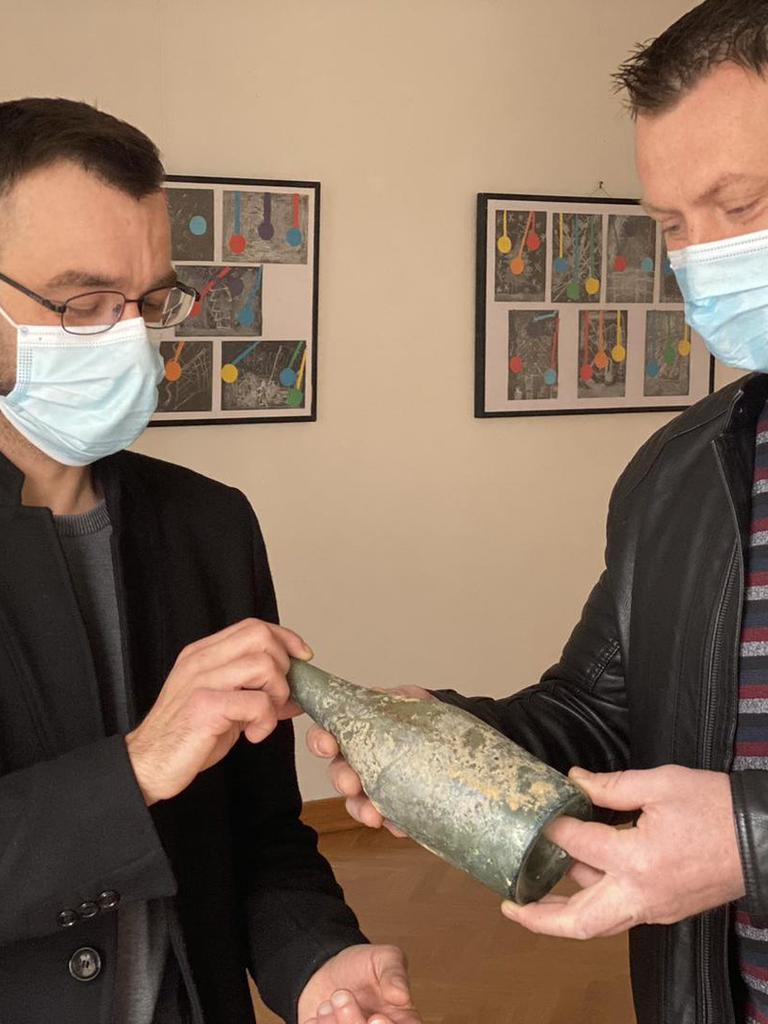 © Robert Turkalj
© Robert Turkalj
The discovery of the Slatina sparkling wine bottle is important to the city and its history. Other regions in Croatia have become extremely well regarded over recent years for their production of quality sparkling wines. The production of Slatina sparkling wine briefly disappeared during a period. But, this bottle is evidence that Slatina sparkling wine was among the first to be made in the country. It is the only fully preserved bottle of the 'Slavonia champagne' to exist in the region.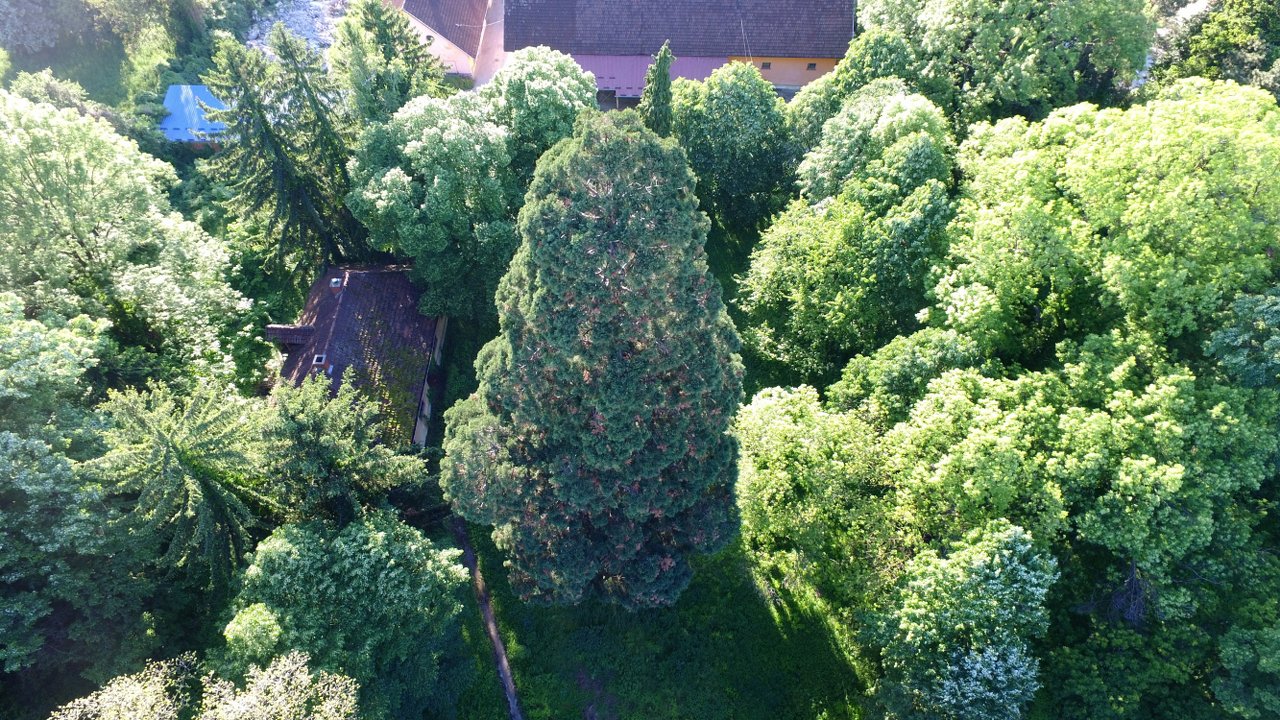 Slatina's nationally protected Giant Sequoia tree (Mamutovac) © Tourist Board of Slatina
Slatina's nationally protected Giant Sequoia tree (Mamutovac) © Tourist Board of Slatina
Of course, we can't really call it champagne – that title is reserved for a type of sparkling wine made in a distinct geographical region in France. But, there are great similarities between Slatina sparkling wine and champagne - similarities that do not exist exactly in other Croatian sparkling wines. Champagne is largely made from the Pinot Noir grape. The found bottle of Slatina sparkling wine was made from the Kadarka grape variety, which has been compared to Pinot Noir.
Both grape varieties are thin-skinned, delicate, easily susceptible to impairment and require a low yield to produce quality wines. Both are tricky to cultivate. For this reason, the Kadarka grape variety is now grown very rarely in Croatia, its place in vineyards taken by more hardy and some imported varietals. But, that wasn't always the case.
History of Slatina sparkling wine
In 1841, the German prince Georg Wilhelm Schaumburg-Lippe bought a property of land in the Slatina area from the Pejačević family. The land contained vineyards, orchards, agricultural fields and large forest areas, including the site of the new Slatina visitor centre where the bottle was discovered. Indeed, trees still line the road of Ulica kralj Zvonimir in the centre of Slatina – the cellar and restaurant of the town's famous Stari Podrum is just a few metres from Slatina's nationally protected Giant Sequoia tree (Mamutovac).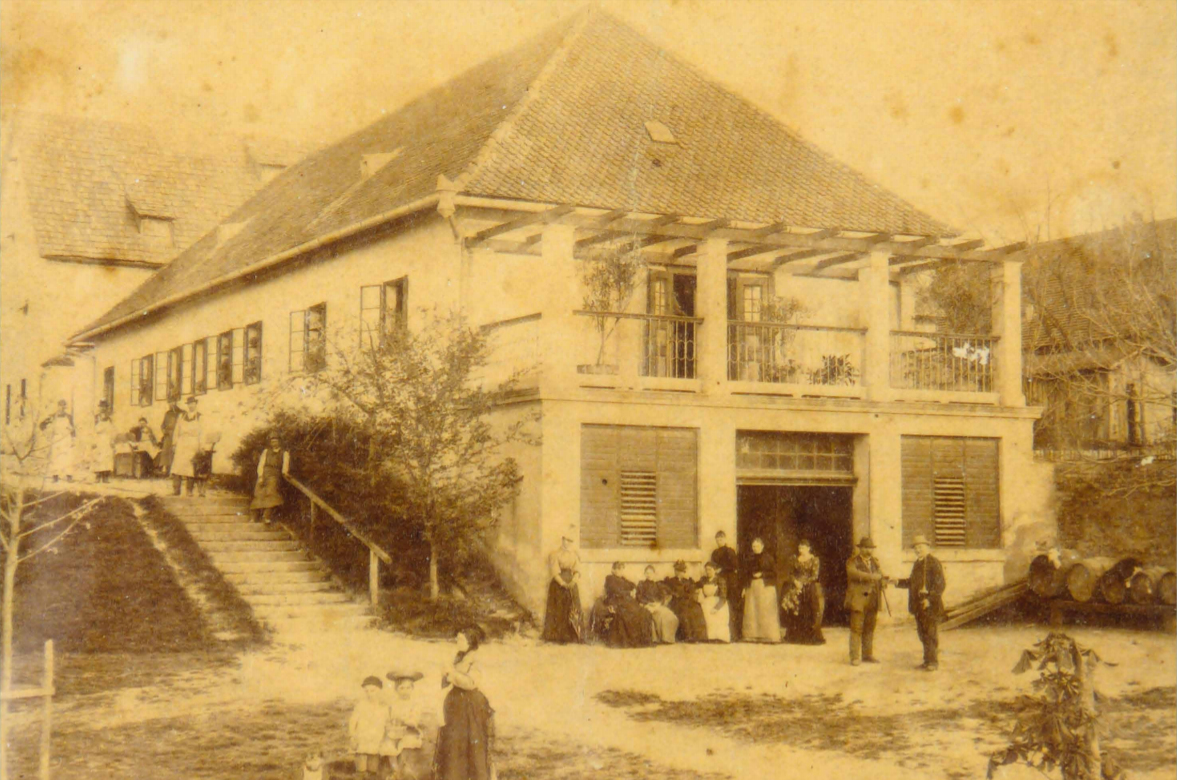 The Stari Podrum cellar, the site of the first-ever production of Croatian sparkling wine, at the beginning of the 20th century © Virovitica State Archives / Slatina Homeland Museum
The Stari Podrum cellar, the site of the first-ever production of Croatian sparkling wine, at the beginning of the 20th century © Virovitica State Archives / Slatina Homeland Museum
Slatina sparkling wine production started in 1864 at the Stari Podrum cellar, using the Kadarka grape variety. Perhaps it was the notorious difficulties of the growing the grape which resulted in slow initial progress for the production, but the enterprise got a massive boost in 1866 with the arrival of a new manager, Otto Rockhror. He rearranged the cellar and production, brought in new equipment and invested in marketing their Slatina sparkling wine. It worked.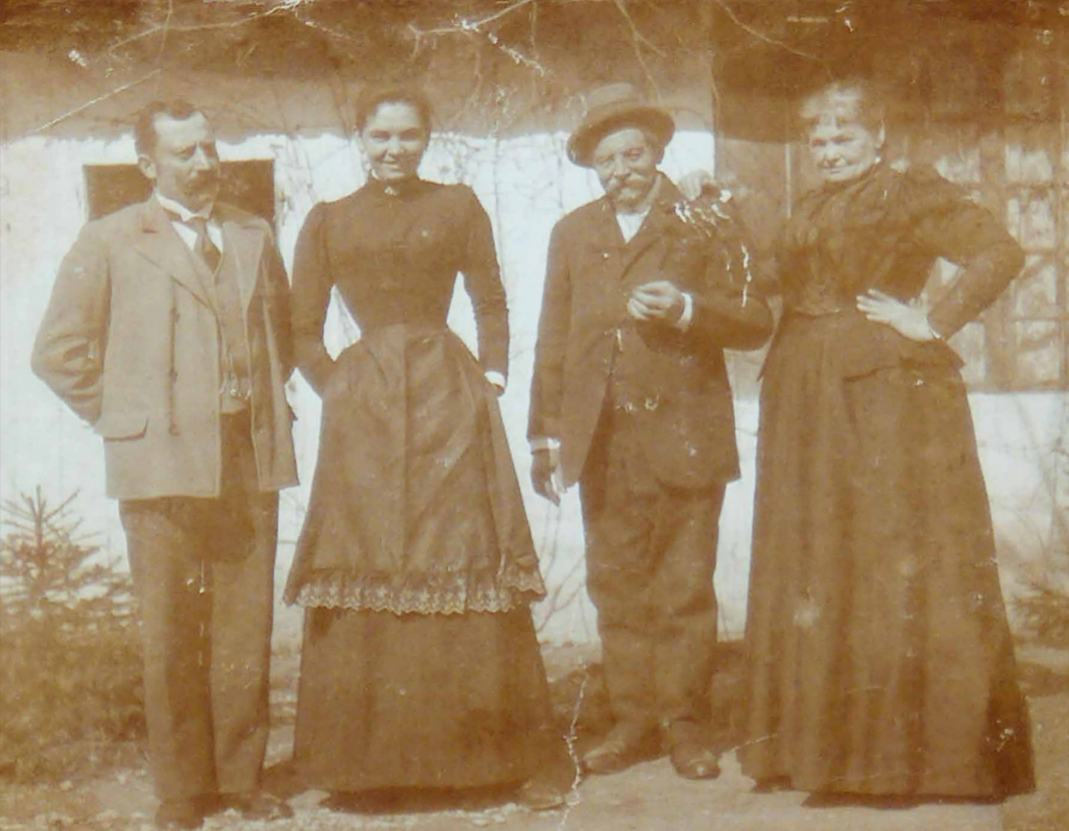 Left to right - Ljudevit Konstantinović, his wife Marija Konstantinović (the daughter of Otto Rockrohr), Otto Rockrohr and his wife Josefina Rockrohr © Virovitica State Archives / Slatina Homeland Museum
Left to right - Ljudevit Konstantinović, his wife Marija Konstantinović (the daughter of Otto Rockrohr), Otto Rockrohr and his wife Josefina Rockrohr © Virovitica State Archives / Slatina Homeland Museum
The quality of Slatina sparkling wine was recognized at the great Economic and Forestry Jubilee Exhibition in Zagreb in 1881 when Georg Wilhelm Schaumburg-Lippe received an honorary diploma and a large medal for domestic sparkling wine and fine wine. The credit perhaps lay elsewhere, considering it was the efforts of Otto Rockhror that were no doubt the cause, but, such were the times. However, Otto Rockhror's achievements with Slatina sparkling wine certainly did not go unnoticed.
At the Science and Industry Fair in Brussels, Belgium, in 1888, Otto Rockhror was awarded a bronze medal featuring the image of Leopold I. He received a further bronze medal with the image of Francis Joseph I in 1890 at the Agricultural and Forestry Exhibition in Vienna and was awarded a silver medal with the image of Franz Ferdinand in 1894 in Vienna by the Association for the Promotion of Agricultural Knowledge. These medals are on display in the Slatina Homeland Museum, donated by Otto Rockhror's great-granddaughter Jasna Nosso. They sit alongside a wooden barrel used in the production of Slatina sparkling wine from 1885 and, now, the latest testament to the history of Croatia's oldest sparkling wine production, the newly discovered bottle, which has been transferred to the museum for preservation, safekeeping and dating.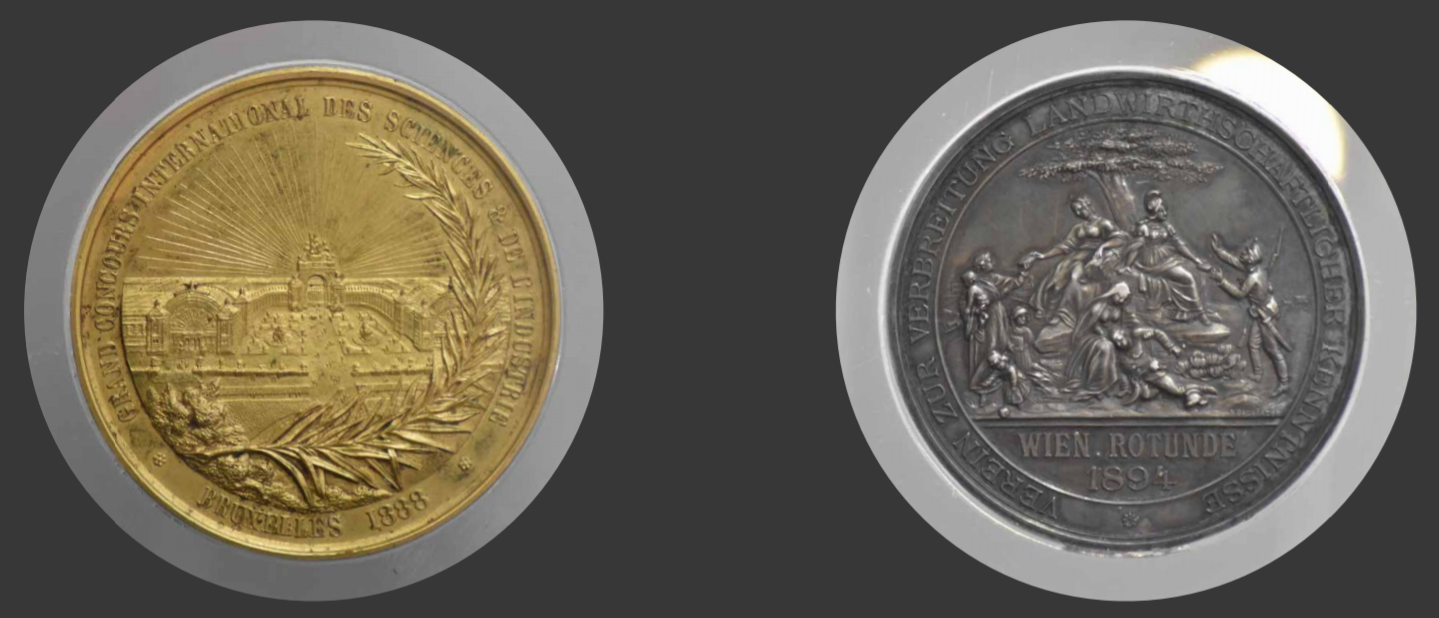 On the left, the bronze medal won by Otto Rockhror at the Science and Industry Fair in Brussels, Belgium, in 1888. On the right, the silver medal with the image of Franz Ferdinand he was awarded in 1894 in Vienna © Virovitica State Archives / Slatina Homeland Museum
On the left, the bronze medal won by Otto Rockhror at the Science and Industry Fair in Brussels, Belgium, in 1888. On the right, the silver medal with the image of Franz Ferdinand he was awarded in 1894 in Vienna © Virovitica State Archives / Slatina Homeland Museum
The production of Slatina sparkling wine from the Kadarka grape did not survive the loss of Stari Podrum cellar manager Otto Rockhror, who died in 1909. Thereafter, ownership of the enterprise was taken over by Count Drašković but, by 1912, production of Slatina sparkling wine had ceased completely and all the production equipment was moved to Hungary. Though the growing of the Kadarka grape variety almost completely died out in Croatia after this, it remains an important part of wine production in Hungary, Bulgaria, Romania and Serbia, where it is grown in Vojvodina, a landscape near-identical to that of Slavonia (indeed, though the heritage of the Kadarka grape is mysterious, the latest opinion is that it is a cross between the Turkish variety Papazkarasi and the Serbian variety Skadarsko and travelled to Pannonia with Serbs who fled north from the Ottomans).
However, the story of Slatina sparkling wine has not only been revived with the discovery of this old bottle. The Stari Podrum cellar still stands in the centre of Slatina today and vineyards still surround the town. The cellar and its wine production were bought by winemaker Ivan Halas over recent years and he has returned the production of Slatina sparkling wine to the historic birthplace of 'Slavonia champagne'. He has since received several awards for his efforts.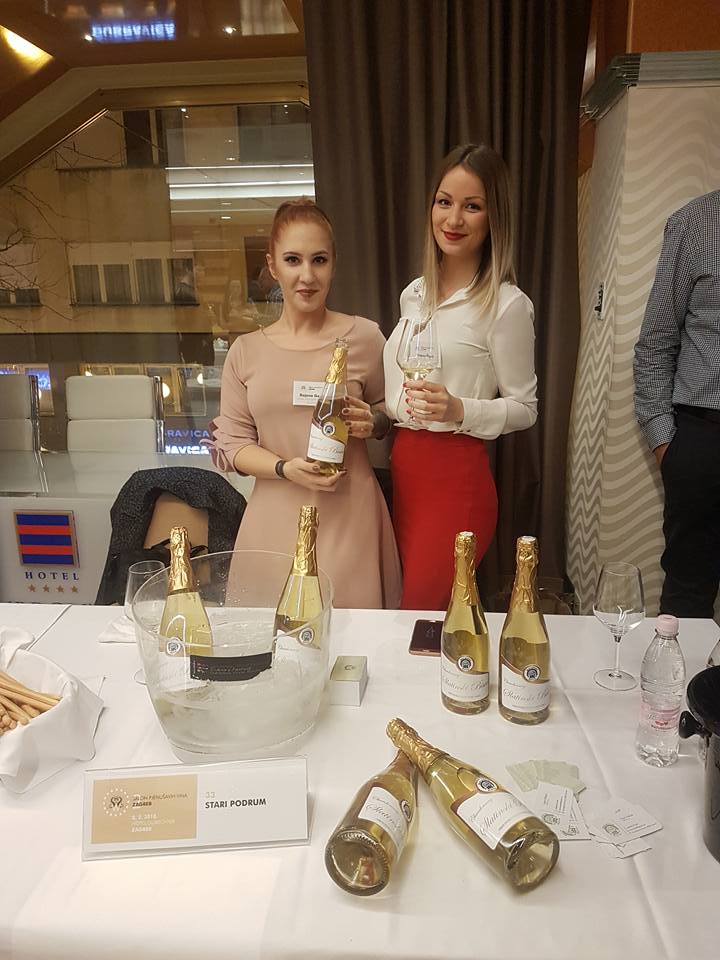 Slatina sparkling wine, revived by Ivan Halas at Stari Podrum, being presented at the 2nd Sparkling Wine Salon at the Hotel Dubrovnik in Zagreb © Tourist Board of Slatina
Slatina sparkling wine, revived by Ivan Halas at Stari Podrum, being presented at the 2nd Sparkling Wine Salon at the Hotel Dubrovnik in Zagreb © Tourist Board of Slatina
“As the Stari Podrum winery does not have adequate conditions for storing the found bottle, we took it to the Homeland Museum in Slatina where it will be stored,” Mr Halas told local news, upon the discovery of the bottle. “Only one bottle was found (so far), although there may be more. It is currently the only fully preserved one in the Slatina area. For now, we assume that it is from the period between 1864 and 1912 - we have no knowledge of the exact year, but the age of the bottle will be determined by experts.”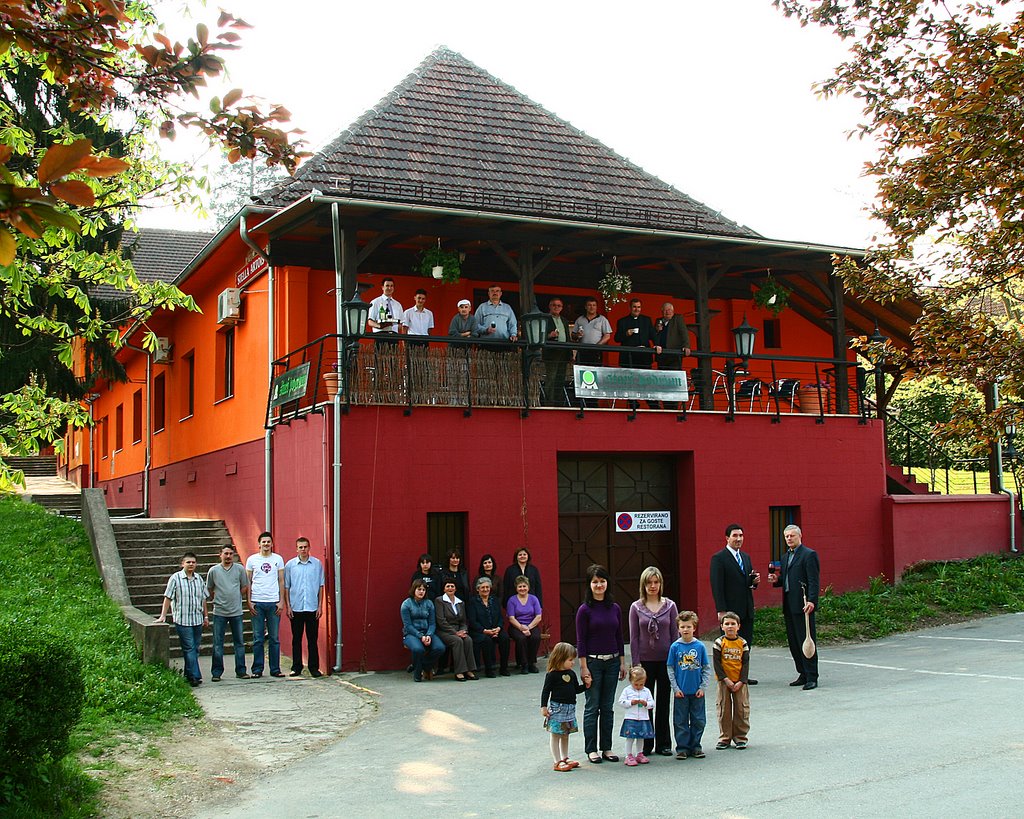 A more contemporary photo of the Stari Podrum enterprise in Slatina © Virovitica State Archives / Slatina Homeland Museum
A more contemporary photo of the Stari Podrum enterprise in Slatina © Virovitica State Archives / Slatina Homeland Museum
Međimurje Wine Region Has Best Sparkling Wines in Croatia!
October 11, 2020 – Sparkling wine Urban white from the Štampar Winery won the gold medal, and Sibon brut from the DGA Sparkling Wine Company won the silver medal at the 17th Decanter World Wine Awards, giving the Međimurje wine region the best sparkling wines in Croatia.
As Večernji.hr reports, this year's prestigious Decanter World Wine Awards 2020 brought numerous awards to Međimurje winemakers, but also a big surprise for all sparkling wine lovers who will from now on certainly include Međimurje sparkling wine in the selection of the best.
The winning sparkling wine Urban white from the Štampar Winery is characterized by a straw-yellow color and persistent and numerous beads, while the smell is extremely pleasant, fresh, and fluttery. Its taste lingers, is elegant, and harmonious, and it goes well with dishes from Međimurje and the continental area, but also Mediterranean cuisines such as oysters, mushroom omelets, creamy risottos, pasta, and quiche.
"This award is an additional confirmation of what we somehow knew deep down based on our previous experiences and wine knowledge. Pušipel is a true sort for the production of sparkling wines and that is exactly the reason why we decided to produce sparkling wine from our indigenous Međimurje sort. With perseverance and the constant searching for knowledge and innovation, we managed to produce a sparkling wine that is today, confirmed at the international level, at the very top of the Croatian wine scene," said David Stampar on the occasion of receiving this important medal.
Also, in addition to the mentioned sparkling wines, in Međimurje County there is a large number of well-known winemakers who prove their wine skills in the field of sparkling wines, and we should mention the excellent sparkling wines Cmrečnjak Wines, Dvanajšćak Kozol Wines, Hažić Wine House, Tomšić Winery and Jakopić Winery, for which valuable medals are also expected in the coming period.
Next to the top sparkling wines at this year's Decanter, there were also excellent wines from Međimurje winemakers, who won seven more silver and six bronze awards, and one in the COMMENDED wine category, which is a wine with a recommendation that only slightly missed some of the awards.
The year 2020 brought four more medals than the previous year, and a total of 15 awards and one recommendation were awarded, which is an excellent result of Međimurje winemakers at the prestigious international wine competition Decanter. Expectations for 2021 are high and further awards are expected.
For the latest travel info, bookmark our main travel info article, which is updated daily.
Read the Croatian Travel Update in your language - now available in 24 languages.
Strawberry and Sparkling Wines Festival in Jastrebarsko
In an attempt to promote some of the best products coming from their region, the Tourist Board of the town of Jastrebarsko has started a new spring-time event taking place in their town: a Strawberry and Sparkling Wine Festival, to be held for the first time next weekend, on May 11th and 12th in Jastrebarsko.
Some of the best wines in Croatia are the sparkling wines made in the Plešivica region (we've written about them previously, and they've received numerous awards and medal in international competitions over the years. At the same time, it's almost impossible to spend any time in Zagreb in May and early June without realizing that region around Zagreb is a major hub of strawberry production, as numerous producers sell their scented red bites of sweetness all over the town, often under the brand "Strawberry Ring" (Jagodni Prsten; the reference to the fact that Zagreb County, where most strawberry producers are located, is basically a ring-like structure around the City of Zagreb).
And everyone knows that strawberries and sparkling wine go well together, if for no other reason because Edward from the Pretty Woman taught us so when he ordered the pair to their room back when he was trying to impress Vivian (and us!) with his bon vivant ways! So, celebrating the two together during the prime season for one of them, in a place where both are created - and not just made, but made in such a way to win awards! - really is a no-brainer.
So, if you like strawberries and sparkling wine, on May 11th and 12th find some time to get to Jastrebarsko, where the event will take place in front of the Erdödy castle (in the park in the centre of the town). On the Saturday at 6 pm a workshop on sparkling wines, moderated by Ivo Kozarčanin will take place (number of attendees limited, apply for it at This email address is being protected from spambots. You need JavaScript enabled to view it. if you wish to attend), and on Sunday around 50 oldtimer cars will make their appearance at the park as well.
As for the winemakers, you won't be disappointed with those bringing their wines to the festival: Ivančić, Jagunić, Kolarić, Korak, Kurtalj, Kunović, Režek, Tomac and Šember. Numerous strawberry growers from the Jagodni prsten association will also be there, and in addition to strawberries themselves, there will be different types of the dessert made with strawberries. Don't miss this perfect combination!
Enjoy Sparkling Wines and the Oscars (Vino&Kino Event) at Bornstein
Vino&Kino (in English the title would be translated as Wine&Movies, so you can appreciate that it does make more sense and rhymes better in Croatian) are a series of events organized by Jelena Bulum, in which she tries to tie together the two worlds that don't seem to have much in common: wine and movies. OK, well, a lot of both is made in California, so they do have something in common.
This Tuesday and Wednesday, on February 5th and 6th, the events will take place in Bornstein wine bar and shop in Zagreb, starting at 7 pm. This will be the first instalment of the events in 2019, and it will be dedicated to the Academy Awards, usually just called the Oscars. This year, the award ceremony will be held on February 24th in Los Angeles, and Vino&Kino will introduce us to some of the favourites for thr prestigious award.
The movies presented will be accompanied by the Oscars' worthy sparkling wines made by the vintners from Plešivica, Drago Kurtalj and Dominik Jagunić. Their wines are also winning awards all over the world, and at the Vino&Kino event, the guests will get the chance to taste Jagunić's Three Stars Brut, Rhein Riesling and Rot-traminer, and Kurtalj's Rosé and Prestige cuvée (2013).
Movies which are considered as this year's favourites for the Oscars will be presented (their trailers will be shown, not the entire movies, of course), and the stories of those movies will be told by Martin Milinković, long-time movie professional and a favourite of the Vino&Kino guests in the past.
Jelena Bulum will be the hostess for the evening, and in addition to the wines you'll get the chance to enjoy the creative bites from the Bornstein kitchen
The first event on Tuesday is already sold out, but you can still get in on Wednesday, and the price of admission is 150 kuna.


